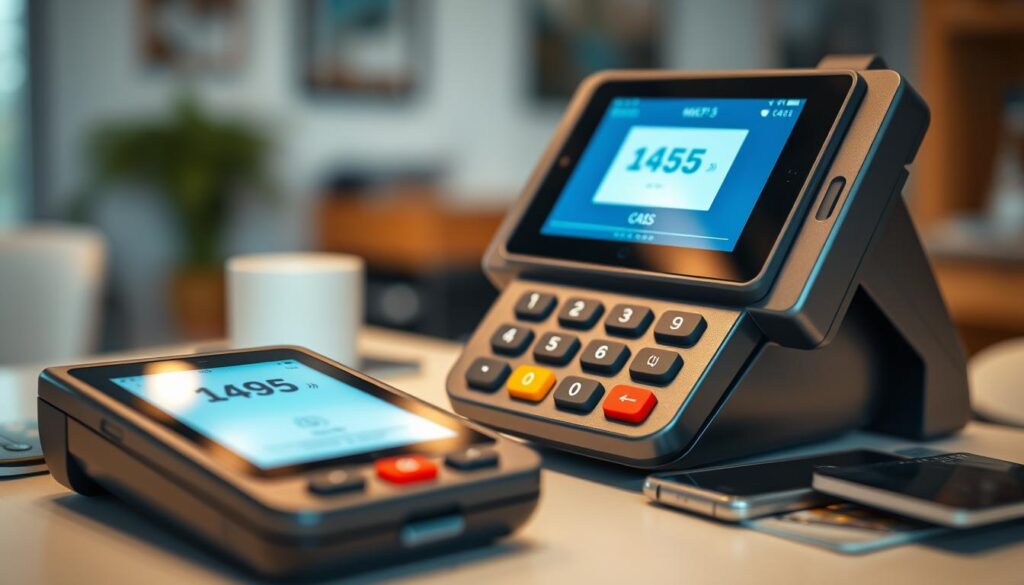In the fast-paced world of finance, knowledge is power. As you embark on your journey towards financial empowerment and independence, understanding the intricacies of payment processing is essential. At Revolution Money Exchange, we are committed to providing you with the insights, tools, and resources you need to navigate the complex landscape of payment processing with confidence.
Payment processing is the sequence of actions that securely transfer funds between a payer and a payee, involving authorization, verification, and settlement of transactions through electronic payment systems. These systems support a wide range of transaction types, including credit and debit cards, electronic funds transfers (EFTs), automated clearing house (ACH) transfers, mobile payments, digital wallets, and cryptocurrencies. With digital payments forecasted to reach $9.5 trillion in 2023, understanding the meaning of “payment in process” and other key terms is crucial for businesses and individuals alike.
Industry changes have led to innovations in payment solutions, increased accessibility to financial services, and heightened competition among providers. Payment processing involves various stakeholders, such as banks, financial institutions, payment processors, technology providers, businesses, and regulatory bodies. Card networks, including Visa, Mastercard, and American Express, establish rules, standards, and infrastructure for transaction processing, ensuring smooth and secure operations.
To protect sensitive payment data, implementing robust security measures like encryption, tokenization, and SSL certificates is paramount. Compliance with PCI DSS and other security standards is necessary to maintain a secure payment environment and build trust with customers. By understanding the meaning of “payment in process” and other key terms, you can optimize your cash flow management, enhance customer experiences, and ensure compliance and security in your financial transactions.
Key Takeaways
- Payment processing securely transfers funds between payers and payees through electronic systems.
- Digital payments are expected to reach $9.5 trillion in 2023, emphasizing the importance of understanding payment processing terms.
- Industry changes have led to innovations, increased accessibility, and heightened competition in payment solutions.
- Stakeholders in payment processing include banks, financial institutions, payment processors, technology providers, businesses, and regulatory bodies.
- Implementing security measures and complying with industry standards are crucial for protecting sensitive payment data and building customer trust.
Introduction to Payment Processing
Payment processing is a crucial aspect of modern business, enabling companies to accept and manage customer payments seamlessly. Understanding the payment process meaning and its various components is essential for businesses looking to optimize their cash flow, enhance customer satisfaction, and minimize fraud risks.
When a customer makes a payment, the transaction goes through several stages before the funds are deposited into the merchant’s account. If a payment is processed, it means that the transaction has been authorized, cleared, and settled by the various entities involved in the payment processing system.
Payment processing typically involves the following costs for businesses:
| Payment Processor | Fees |
|---|---|
| Square | 10-cent fee on most card transactions, plus 2.6% of payment volume |
| Stripe | 2.9% + 30 cents per transaction for payment gateway services |
| Payment Gateways | Initial setup fees, flat monthly fee, and a small fee for each transaction |
As the payment industry evolves alongside technological advancements and changing customer behavior, businesses must stay informed about industry trends, regulations, and security standards. This allows them to adapt to the changing landscape and provide a secure, efficient payment experience for their customers.
Building a minimal payment gateway to process credit and debit card transactions could cost a quarter of a million dollars, according to technology consulting firm Softjourn.
To ensure a smooth payment process, businesses should implement robust payment approval workflows that account for scenarios such as team member absences, emergency cases requiring expedited approvals, fraud detection, and compliance with regulations and auditing requirements. By understanding what it means when a payment is processed and implementing best practices, businesses can streamline their payment operations and focus on growth.
Components of the Payment Processing System
The payment processing system is a complex network of various components that work together to facilitate smooth and secure transactions. Each component plays a crucial role in ensuring that payments are processed efficiently and accurately. Let’s take a closer look at the key elements of this system.
Merchants and Customers
At the heart of the payment processing system are merchants and customers. Merchants are businesses that sell goods or services and accept payments from customers. Customers, on the other hand, are individuals or entities that purchase these goods or services and make payments to merchants. The interaction between merchants and customers initiates the payment processing cycle.
Payment Methods and Instruments
Customers can choose from various payment methods and instruments to make purchases. These include credit cards, debit cards, prepaid cards, digital wallets, and bank transfers. Each payment method has its own set of features, benefits, and security measures. Merchants must support multiple payment options to cater to their customers’ preferences and enhance the overall shopping experience.
Payment Gateways and Processors
Payment gateways and processors are the technological backbone of the payment processing system. A payment gateway is a software application that securely transmits transaction data between the merchant’s website or point-of-sale system and the payment processor. The payment processor, in turn, communicates with the acquiring and issuing banks to authorize and settle transactions. These components ensure that sensitive payment information is encrypted and transmitted securely.
Acquiring and Issuing Banks
Acquiring banks, also known as merchant banks, are financial institutions that provide merchants with accounts to accept payments. They work closely with payment processors to facilitate the transfer of funds from customers’ accounts to merchants’ accounts. Issuing banks, on the other hand, are financial institutions that provide customers with payment cards and manage their accounts. They are responsible for approving or declining transactions based on the customer’s account status and available funds.
Card Networks and Associations
Card networks, such as Visa, Mastercard, and American Express, are the intermediaries that connect acquiring and issuing banks. They establish the rules, regulations, and standards that govern the payment processing system. Card associations, like Discover and JCB, also play a similar role. These networks and associations facilitate the exchange of transaction data and funds between banks, ensuring interoperability and security across the global payment ecosystem.
| Component | Role |
|---|---|
| Merchants | Sell goods or services and accept payments |
| Customers | Purchase goods or services and make payments |
| Payment Methods | Credit cards, debit cards, digital wallets, etc. |
| Payment Gateways | Securely transmit transaction data |
| Payment Processors | Communicate with banks to authorize and settle transactions |
| Acquiring Banks | Provide merchants with accounts to accept payments |
| Issuing Banks | Provide customers with payment cards and manage accounts |
| Card Networks | Establish rules and facilitate data and fund exchange |
Understanding the process for payment meaning and the role of each component in the payment processing system is essential for businesses to streamline their operations, enhance customer satisfaction, and maintain a competitive edge in today’s digital marketplace.
How Payment Processing Works: A Step-by-Step Guide
Payment processing is a complex yet essential aspect of modern commerce. Understanding the various steps involved in processing payments can help businesses optimize their operations and provide a seamless customer experience. Let’s take a closer look at the payment processing workflow.
Transaction Initiation
The payment processing journey begins when a customer initiates a transaction by presenting their payment card or entering their card details online. This information is securely transmitted to the payment gateway, which acts as a mediator between the merchant and the payment processor. Payment gateways are crucial for transferring cardholder information, ensuring a smooth and secure transaction process.
Authorization and Verification
Once the payment gateway receives the transaction details, it forwards the information to the payment processor. The processor then communicates with the customer’s issuing bank to verify the availability of funds and the validity of the card. This authorization process involves a series of checks, including fraud detection and compliance with industry regulations such as PCI DSS. If the transaction is approved, the issuing bank sends an authorization response back through the card network to the payment processor.
Clearing and Settlement
After the transaction is authorized, the clearing and settlement process begins. The payment processor captures the funds from the customer’s account and deposits them into the merchant’s account. This process involves the transfer of financial information from the customer to the payment gateway, then to the payment processor, card network, customer’s bank, and back through the network. Card networks, such as Visa, Mastercard, American Express, and Discover, play a crucial role in facilitating this exchange of funds.
Reconciliation and Reporting
The final step in the payment processing workflow is reconciliation and reporting. Payment processors provide detailed reports to merchants, allowing them to reconcile their transactions and monitor their financial performance. These reports include information such as transaction volumes, fees, and chargebacks. By regularly reviewing these reports, businesses can gain valuable insights into their payment processing operations and make informed decisions to optimize their cash flow management.
| Payment Processing Step | Description |
|---|---|
| Transaction Initiation | Customer presents payment card or enters card details online |
| Authorization and Verification | Payment gateway forwards transaction details to payment processor for authorization |
| Clearing and Settlement | Payment processor captures funds from customer’s account and deposits them into merchant’s account |
| Reconciliation and Reporting | Payment processors provide detailed reports to merchants for reconciliation and monitoring |
Understanding the process payment meaning and the various steps involved in processing the payment is essential for businesses to streamline their operations and enhance the customer experience. By partnering with reliable payment processors and implementing secure payment solutions, businesses can ensure compliance, reduce the risk of fraud, and optimize their cash flow management.
Common Payment Processing Terms and Their Meanings
When navigating the world of payment processing, it’s essential to understand the various terms and acronyms used in the industry. Knowing what these payment processing terms mean can help businesses streamline their operations and enhance customer experience. Let’s explore some of the most common payment processing terms and their meanings.
One of the most frequently used terms is “net,” followed by a number, such as net 7, net 15, net 30, net 45, net 60, and net 90. These terms refer to the number of days a customer has to pay an invoice after it has been issued. For example, net 30 payment terms, one of the most prevalent in business transactions, mean that payment is due 30 days after the invoice date.
- PIA (Payment in Advance): Commonly used by freelancers and independent contractors
- CIA (Cash in Advance): Typical for products that require shipping, especially in trade agreements and online marketplaces
- COD (Cash on Delivery): Payment is made upon receiving the product
- Due Upon Receipt: Requires immediate payment upon receipt of the invoice
- Line of Credit: Enables buyers to purchase goods or services on credit and pay according to an agreed-upon schedule
Other terms you may encounter include EOM (End of Month), 15 MFI (Month Following Invoice), 50% upfront payment, CBS (Cash Before Shipment), PPD (Professional Payment Due), CAD (Cash Against Documents), and CND (Cash Next Delivery). Each of these terms has specific implications for when and how payment is processed and received.
| Term | Meaning |
|---|---|
| Net 7, 15, 30, 45, 60, 90 | Number of days to pay invoice after issue date |
| PIA (Payment in Advance) | Payment made before work begins |
| CIA (Cash in Advance) | Payment made before goods are shipped |
| COD (Cash on Delivery) | Payment made upon receiving the product |
| Due Upon Receipt | Immediate payment upon invoice receipt |
Understanding what these payment processing terms mean is crucial for businesses looking to optimize their cash flow management and provide a seamless customer experience. By familiarizing yourself with these common terms, you can better navigate the payment processing landscape and make informed decisions for your business.
The Importance of Understanding Payment in Process Meaning
Understanding the meaning of “payment in process” is crucial for businesses to streamline their financial operations and provide a seamless customer experience. When a payment is processed, it means that the funds are being transferred from the customer’s account to the merchant’s account, following a series of steps involving authorization, clearing, and settlement.
Grasping the intricacies of payment processing enables businesses to make informed decisions about their payment systems, ultimately leading to improved customer satisfaction, optimized cash flow management, and enhanced security and compliance.
Enhancing Customer Experience
By comprehending what it means when a payment is processed, businesses can offer a variety of payment options tailored to their customers’ preferences. This flexibility not only improves the overall customer experience but also reduces the likelihood of abandoned transactions. Some common payment methods include:
- Credit cards, which typically charge a fee (percentage of transaction amount and/or flat fee) to merchants accepting them
- Debit cards, which usually do not have annual fees or transaction costs unless overdrawing occurs
- Cash transactions, which do not incur hidden fees or transaction costs
- Mobile payments, which promote financial security through tokenized mobile payment apps
Optimizing Cash Flow Management
Efficient payment processing is vital for maintaining a healthy cash flow. By understanding the payment processing timeline, businesses can better forecast their incoming funds and manage their expenses accordingly. This knowledge also helps in negotiating favorable terms with payment processors and minimizing transaction fees, such as the 2-3% foreign exchange transaction fees that may apply when making payments in another currency.
Ensuring Compliance and Security
Payment processing involves sensitive financial data, making compliance and security paramount. Businesses must adhere to industry regulations and security standards, such as PCI DSS, to protect their customers’ information and maintain trust. By staying informed about payment processing best practices, including tokenization and encryption, companies can mitigate the risk of data breaches and fraud.
In summary, understanding what payment processing means is essential for businesses to enhance customer experience, optimize cash flow management, and ensure compliance and security. By staying informed about the various aspects of payment processing, companies can make strategic decisions that contribute to their long-term success and growth.
Best Practices for Efficient Payment Processing
To ensure a smooth and secure payment process, businesses must adopt best practices that optimize their payment processing systems. By implementing these strategies, companies can enhance customer satisfaction, maintain a steady cash flow, and protect sensitive financial data from potential threats.

Choosing the Right Payment Processor
Selecting a reliable payment processor is crucial for efficient payment processing. Consider factors such as transaction fees, security features, customer support, and compatibility with your existing systems. According to a recent survey, 68% of companies noted an increased misconduct risk due to COVID-19, highlighting the importance of choosing a trustworthy payment processor.
Implementing Secure Payment Solutions
Protecting sensitive customer data is paramount in the process for payment. Implement secure payment solutions like encryption and tokenization to safeguard financial information during transactions. Additionally, adhering to regulatory standards set by bodies like the Financial Action Task Force (FATF) and Consumer Financial Protection Bureau (CFPB) ensures compliance and reduces the risk of fraud.
Regularly Monitoring and Analyzing Payment Data
Regularly monitoring and analyzing payment data is essential for identifying trends, detecting anomalies, and optimizing performance. By tracking key metrics such as transaction volume, approval rates, and chargeback ratios, businesses can make data-driven decisions to improve their payment in process efficiency. J.P. Morgan’s 2022 AFP Payments Fraud and Control Survey revealed that 71% of organizations were victims of payment fraud attacks or attempts in 2021, emphasizing the importance of vigilant monitoring.
Having at least two individuals involved in the payment of each invoice reduces human error and internal fraud risk.
Implementing best practices like segregation of duties and balancing responsibilities can further enhance the security and efficiency of the payment processing system. By staying proactive and adapting to the evolving payment landscape, businesses can ensure a seamless and secure payment experience for their customers.
Emerging Trends in Payment Processing
The world of payment processing is undergoing a significant transformation, with new technologies and changing consumer preferences driving the evolution of how we process payments. From contactless payments to mobile wallets and cryptocurrency transactions, businesses must stay informed about these emerging trends to maintain a competitive edge in the market.
One of the most notable trends is the rise of cashless payments. Global cashless payment volumes have been steadily increasing, driven by the convenience, security, and speed they offer. Consumers are embracing digital payment methods such as credit cards, mobile payment apps, and contactless technologies, leading to a shift towards cashless transactions. In the United States alone, the mobile payment market was valued at $53.5 billion in 2022 and is expected to reach over $607.9 billion by 2030.
The growth of e-commerce and digital marketplaces has also contributed to the surge in online payments. Financial organizations are adopting innovative payment solutions to meet consumer demands, with payment gateways becoming an increasingly sought-after tool in 2024. These gateways provide businesses with a secure way to process online transactions, ensuring a seamless and personalized payment experience for users.
Mobile wallet applications like Apple Pay, Google Pay, and Samsung Pay have gained significant traction due to their convenience and contactless nature. Transactions through mobile wallets are expected to grow from around $802 billion in 2023 to $929.8 billion in 2024. Additionally, peer-to-peer (P2P) payment solutions such as Stax, Venmo, PayPal, and Cash App have simplified transactions between individuals and enabled seamless digital transfers.
| Payment Trend | Key Statistics |
|---|---|
| Real-time payments | Market growth forecasted to reach USD 86.89 billion by 2028 with a CAGR of 32% from 2022 to 2028 |
| Account-to-account (A2A) payments | Predicted significant growth in the U.S. by late 2024, driven by the launch of FedNow instant payments service and Real Time Payments network |
| Buy now, pay later (BNPL) | From 2019 to 2021, BNPL loans from five primary lenders grew more than 970% according to the Consumer Protection Financial Bureau |
| Social commerce | Revenue generated from social commerce is expected to surpass six trillion dollars by 2030 |
As payment processing continues to evolve, businesses must adapt to these emerging trends to meet customer expectations and maintain a competitive advantage. By staying informed and implementing secure, efficient, and user-friendly payment solutions, companies can optimize their cash flow management and enhance the overall customer experience.
Challenges and Risks in Payment Processing
Payment processing is a complex and dynamic field that presents various challenges and risks for businesses and financial institutions. As technology advances and consumer behaviors evolve, it’s crucial to stay informed about potential hurdles and implement effective strategies to mitigate risks. Let’s explore some of the key challenges and risks associated with payment processing.
Fraud Prevention and Management
Fraud is a significant concern in the payment processing industry, with an estimated 468 billion payment card transactions processed globally each year. Fraudulent activities can lead to financial losses, damage to reputation, and loss of customer trust. To combat fraud, businesses must implement robust fraud prevention and management strategies, such as:
- Utilizing advanced fraud detection tools and algorithms
- Implementing strong authentication measures, such as two-factor authentication
- Regularly monitoring and analyzing transaction data for suspicious patterns
- Educating customers about safe payment practices and potential scams
Regulatory Compliance and Industry Standards
Payment processing is subject to various regulations and industry standards designed to protect consumers and ensure the integrity of the financial system. Failure to comply with these requirements can result in hefty fines, legal repercussions, and reputational damage. Some key regulatory and industry standards include:
- Payment Card Industry Data Security Standards (PCI DSS)
- Know Your Customer (KYC) and Anti-Money Laundering (AML) regulations
- General Data Protection Regulation (GDPR) for businesses operating in the European Union
- Federal Reserve’s Payment System Risk (PSR) policy, which includes public and private-sector payment systems that settle a daily aggregate gross value of U.S. dollar-denominated transactions above a specified threshold

Technological Advancements and Disruptions
The payment processing landscape is constantly evolving, with new technologies and innovations emerging at a rapid pace. While these advancements offer opportunities for improved efficiency, security, and customer experience, they also present challenges and risks. Some examples include:
- The rise of mobile and contactless payments
- The adoption of blockchain and cryptocurrency in payment processing
- The increasing prevalence of open banking and API-driven payment solutions
- The need for seamless integration between payment systems and other business applications
To navigate these technological advancements and disruptions, businesses must stay agile, invest in innovation, and collaborate with experienced payment processing partners who can help them adapt to the changing landscape.
Understanding the challenges and risks associated with payment processing is essential for businesses looking to optimize their payment operations and provide a seamless, secure experience for their customers.
By implementing effective fraud prevention strategies, staying compliant with industry standards, and embracing technological advancements, businesses can minimize risks and position themselves for success in the ever-evolving world of payment processing.
| Top U.S. Card Issuers | Roles and Responsibilities |
|---|---|
| Chase | Offering unsecured loans to cardholders, collecting interest if loans are not repaid within a certain timeframe |
| Bank of America | Initiating refunds in the case of a chargeback, working with acquirers to ensure smooth transaction processing |
| Capital One | Maintaining close communication with acquirers for recurring transactions, such as monthly subscriptions |
As businesses navigate the complex world of payment processing, it’s essential to understand the roles and responsibilities of key players, such as issuers and acquirers. By fostering strong relationships and clear communication between these entities, businesses can ensure a seamless payment experience for their customers while minimizing risks and challenges associated with the payment process meaning.
The Future of Payment Processing
As technology advances and consumer preferences evolve, the payment processing landscape is undergoing a significant transformation. The future of payment processing is set to be shaped by the continued growth of digital payments, the adoption of emerging technologies, and the increasing demand for seamless, secure, and personalized payment experiences.
One of the most notable trends in payment processing is the shift towards cashless transactions. According to PWC research, cashless uptake globally is predicted to increase by 200% by 2030. In the US, physical cash transactions account for fewer than 19% of sales, while in the UK, checks make up less than 1% of retail bank payments, and cash represents only 6% of the market. This trend is driven by the growing preference for faster and smoother payment processes, as reflected in the increasing popularity of digital wallets.
Emerging technologies such as blockchain, artificial intelligence, and biometrics are also expected to play a significant role in the future of payment processing. The Web3 Blockchain market is forecasted to grow at a CAGR of 41.6% between 2022 and 2028, reaching $23.3 billion by 2028. The Biometric Payment Cards market is anticipated to increase to $15498.82 million by 2032 from $73.5 million in 2022. These technologies aim to enhance security, reduce fraud, and provide a more seamless payment experience for users.
Another notable trend is the rise of Buy Now, Pay Later (BNPL) services, which have seen a surge in popularity, partly accelerated by the pandemic. BNPL users totaled 360 million in 2022 and are expected to rise to 900 million by 2027. This trend allows consumers to spread the cost of purchases and manage their cash flow more effectively.
| Payment Method | Current Market Value | Projected Market Value | Projected Growth |
|---|---|---|---|
| P2P Payments | $2.21 trillion (2021) | $11.62 trillion (2032) | 426% |
| Cryptocurrencies | $1294.1 million (2023) | $4853.8 million (2033) | 275% |
| Biometric Payment Cards | $73.5 million (2022) | $15498.82 million (2032) | 20,989% |
The future of payment processing is also likely to be influenced by the entry of Big Tech companies like Google and Apple into the sector, offering merchant services within their widely-used platforms. Additionally, the rise of super apps, such as WeChat and Alipay, which have gained significant traction overseas with over 1.3 billion users, is reshaping the payment industry with their multi-functional capabilities.
Experts predict that by 2024, mobile wallets will surpass traditional credit/debit cards as the most popular online payment method.
As the payment processing industry continues to evolve, businesses that embrace innovation and adapt to these changes will be well-positioned to thrive in the future. Understanding what payment processing means and staying informed about the process for payment meaning will be crucial for businesses to optimize their payment strategies and meet the ever-changing needs of their customers.
Conclusion
As businesses navigate the complex world of payment processing, understanding key terms like “payment in process meaning,” “process payment meaning,” and “what does process payment mean” is crucial. By grasping the nuances of these concepts, companies can optimize their payment workflows, enhance customer experiences, and maintain a healthy cash flow.
Staying informed about the latest trends, best practices, and challenges in the payment processing industry empowers businesses to make strategic decisions. From implementing secure payment solutions to monitoring and analyzing payment data, a proactive approach can help mitigate risks such as fraud and ensure compliance with regulatory standards.
As technology continues to advance and consumer preferences evolve, the future of payment processing looks promising. By embracing innovation and adapting to changing market dynamics, businesses can position themselves for long-term success. Understanding the meaning behind terms like “payment in process” and “process the payment” is just the beginning of a journey towards building a robust and efficient payment processing strategy.
In conclusion, mastering the language of payment processing is essential for businesses to thrive in today’s digital economy. By staying informed, implementing best practices, and embracing change, companies can navigate the complexities of payment processing with confidence, ultimately driving growth and success in an increasingly competitive landscape.
FAQ
What is payment processing?
What are the components of a payment processing system?
How does the payment processing workflow work?
What are some common payment processing terms?
Why is understanding payment processing important for businesses?
What are some best practices for efficient payment processing?
What are some emerging trends in payment processing?
What challenges and risks are associated with payment processing?
What does the future of payment processing look like?
Source Links
- Payment processing: How payment processing works | Stripe
- What Does it Mean When a Payment is Pending
- What Is a Payment Gateway? How It Works and Example
- Streamlining Your Payment Process: An Introduction to Payment Approval Workflows | Paytron Blog
- What are payment gateways? | Stripe
- Straight-Through Processing (STP): Definition and Benefits
- What is Invoice Processing? Definition, Steps, Flowchart & Software
- What Is a PSP (Payment Service Provider)?
- How payment transaction processing works | Stripe
- What is a Payment Processor?
- How Online Payment Processing Works
- Understanding the Meaning of Payment in Process | Nadapayments
- Defining Every Common Invoice Payment Term | altLINE
- Guide to Payment Types, With Pros and Cons for Each
- Methods of Payment
- Understanding Its Definition and Importance
- Payment industry ecosystem: A guide for businesses | Stripe
- Internal Controls for Accounts Payable | MineralTree
- Top 7 Payment Trends To Watch In Payment Processing
- Top 9 Payments Industry Trends to Keep an Eye on in 2024 – Softjourn
- Payment Trends in 2024
- Payment System Risk
- Understanding payment processing: Acquirer vs. issuer | Stripe
- What Is The Future Of Payments? Trends To Keep An Eye On | Stax Payments
- 12 Payment Processing Trends to Watch in 2024 | SPD Technology
- The Future Of Payment Processing: Key Trends For The Next Decade
- Account Settlement: Definition, Types, Example
- Research Guides: Organizing Your Social Sciences Research Paper: 9. The Conclusion
- Inferences and Conclusions | Cuesta College



